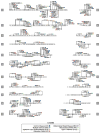The genomics of autoimmune disease in the era of genome-wide association studies and beyond
- PMID: 22001415
- PMCID: PMC3288956
- DOI: 10.1016/j.autrev.2011.10.003
The genomics of autoimmune disease in the era of genome-wide association studies and beyond
Abstract
Recent advances in the field of genetics have dramatically changed our understanding of autoimmune disease. Candidate gene and, more recently, genome-wide association (GWA) studies have led to an explosion in the number of loci and pathways known to contribute to autoimmune phenotypes. Since the 1970s, researchers have known that several alleles in the MHC region play a role in the pathogenesis of many autoimmune diseases. More recent work has identified numerous risk loci involving both the innate and adaptive immune responses. However, much remains to be learned about the heritability of autoimmune conditions. Most regions found through GWA scans have yet to isolate the association to the causal allele(s) responsible for conferring disease risk. A role for rare variants (allele frequencies of <1%) has begun to emerge. Future research will use next-generation sequencing (NGS) technology to comprehensively evaluate the human genome for risk variants. Whole-transcriptome sequencing is now possible, which will provide much more detailed gene expression data. The dramatic drop in the cost and time required to sequence the entire human genome will ultimately make it possible for this technology to be used as a clinical diagnostic tool.
Copyright © 2011 Elsevier B.V. All rights reserved.
Figures


References
-
- Lander ES, Linton LM, Birren B, Nusbaum C, Zody MC, Baldwin J, et al. Initial sequencing and analysis of the human genome. Nature. 2001;409:860–921. - PubMed
-
- Venter JC, Adams MD, Myers EW, Li PW, Mural RJ, Sutton GG, et al. The sequence of the human genome. Science. 2001;291:1304–51. - PubMed
-
- Anaya JM, Tobon GJ, Vega P, Castiblanco J. Autoimmune disease aggregation in families with primary Sjogren’s syndrome. J Rheumatol. 2006;33:2227–34. - PubMed
Publication types
MeSH terms
Grants and funding
- AR056360/AR/NIAMS NIH HHS/United States
- P50 AR060804/AR/NIAMS NIH HHS/United States
- RC2 HL101499/HL/NHLBI NIH HHS/United States
- RR020143/RR/NCRR NIH HHS/United States
- AI082714/AI/NIAID NIH HHS/United States
- R01 AR050782/AR/NIAMS NIH HHS/United States
- DE018209/DE/NIDCR NIH HHS/United States
- R01 AR043274/AR/NIAMS NIH HHS/United States
- R01 DE018209/DE/NIDCR NIH HHS/United States
- AR058959/AR/NIAMS NIH HHS/United States
- R01 AI063274/AI/NIAID NIH HHS/United States
- P20 RR020143-06/RR/NCRR NIH HHS/United States
- P20 RR020143/RR/NCRR NIH HHS/United States
- U19 AI082714/AI/NIAID NIH HHS/United States
- R56 AI063274/AI/NIAID NIH HHS/United States
- AI083194/AI/NIAID NIH HHS/United States
- N01 AR062277/AR/NIAMS NIH HHS/United States
- 1RC2HL101499-01/HL/NHLBI NIH HHS/United States
- R01 AR056360/AR/NIAMS NIH HHS/United States
- AI063274/AI/NIAID NIH HHS/United States
- RC2 AR058959/AR/NIAMS NIH HHS/United States
- AR043274/AR/NIAMS NIH HHS/United States
- P01 AI083194/AI/NIAID NIH HHS/United States
LinkOut - more resources
Full Text Sources
Medical
Research Materials

